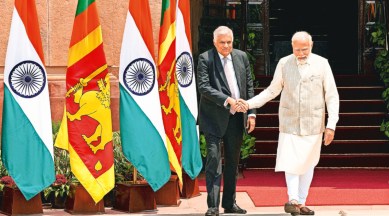India and Sri Lanka on Friday adopted a ‘vision document’ for a deeper economic partnership after talks between Sri Lankan President Ranil Wickremesinghe and Prime Minister Narendra Modi here on Friday.
This is Wickremesinghe’s first visit to India since he assumed office a year ago after an economic crisis triggered widespread protests in Sri Lanka and forced his predecessor, Gotabaya Rajapaksa, to flee. India played a significant role in helping Sri Lanka tide over the crisis.
After the talks, Prime Minister Modi said the vision document was aimed at accelerating “mutual cooperation in tourism, power, trade, higher education and skill development”. He called the document a “vision of India’s long-term commitment towards Sri Lanka”.
“Today, we have adopted a vision document for our economic partnership. This vision is to strengthen Maritime, Air, Energy and people-to-people connectivity between the people of both countries…,” Modi said.
Modi also conveyed to Wickremesinghe New Delhi’s expectations on fulfilling the aspirations of the Tamil community living in Sri Lanka.
“We hope that the Government of Sri Lanka will fulfil the aspirations of the Tamils… ensure a life of respect and dignity for the Tamil community of Sri Lanka… We also discussed the issues related to the livelihood of fishermen. We agree that we should proceed with a humane approach in this matter,” Modi said.
In his remarks, Wickremesinghe said he conveyed to Modi his country’s “profound appreciation” for the solidarity and support in what was “undoubtedly the most challenging period in our recent history”.
Story continues below this ad
“We believe that India’s growth would be beneficial to the neighbourhood and Indian Ocean Region,” Wickremesinghe said.
The ‘vision document’ adopted Friday is based on five pillars: maritime connectivity; air connectivity; energy and power connectivity; trade, economic and financial connectivity, and people-to-people connectivity.
ExplainedStronger partnership
The economic crisis and political chaos in Sri Lanka last year prompted India to step in with help, as Beijing looked the other way. Delhi and Colombo have found themselves closer, and the economic vision document is a clear expression of the partnership.
On maritime connectivity, it outlines cooperation in development of ports and logistics at Colombo, Trincomalee and Kankesanthurai, with an aim to consolidate regional logistics and shipping. It also talks of resumption of passenger ferry services between Nagapattinam in India and Kankesanthurai in Sri Lanka besides working towards early resumption of ferry services between Rameshwaram and Talaimannar.
The document also mentions expansion of flights between Chennai and Colombo, besides exploring connectivity between Chennai and Trincomalee, Batticaloa and other destinations in Sri Lanka. This will, according to the document, “encourage and strengthen investment and cooperation in civil aviation, including augmentation of airport infrastructure at Palaly for greater economic benefits to the people.”
Story continues below this ad
On energy and power connectivity, the two sides plan to “establish a high capacity power grid interconnection… to enable bidirectional electricity trade between Sri Lanka and other regional countries, including those of the BBIN (Bangladesh, Bhutan, India, Nepal) initiative. This has the potential to not only bring down the costs of electricity in Sri Lanka but also help create a valuable and dependable source of foreign exchange for Sri Lanka, the document said.
The document also talks of expediting “implementation of understanding reached” on the Sampur Solar power project and LNG infrastructure, and exploring cooperation in Green Hydrogen and Green Ammonia.”
The two countries will also be working on a multi-product petroleum pipeline from India’s South to Sri Lanka, besides undertaking a “mutually agreed” joint exploration and production of hydrocarbons in Sri Lanka’s offshore basins to develop Sri Lanka’s upstream petroleum sector.
According to the document, the two sides will also “undertake discussions on the Economic and Technology Cooperation Agreement with an aim to comprehensively enhance bilateral trade and investments in new and priority areas.”
Story continues below this ad
According to the document, the “decision to designate Indian Rupee as currency for trade settlements between the two countries has forged stronger and mutually-beneficial commercial linkages”. It said both sides agreed to operationalise “UPI-based digital payments for further enhancing trade and transactions between businesses and common people”.
The two sides also “agreed to leverage India’s Digital Public Infrastructure in accordance with Sri Lanka’s requirements and priorities towards effective and efficient delivery of citizen-centric services to the people of Sri Lanka”.
The two countries also plan “to promote awareness and popularize India’s Buddhist circuit, and Ramayana trail as well as ancient places of Buddhist, Hindu and other religious worship in Sri Lanka for enhancing tourism”, besides exploring cooperation between educational institutions.
“To expand cooperation between research and academic institutes in areas of mutual interests such as agriculture, aquaculture, IT, business, finance and management, health and medicine, earth and marine sciences, oceanography, space applications, as well as history, culture, languages, literature, religious studies and other humanities,” the document said.
Story continues below this ad
Wickremesinghe, who reached New Delhi on Thursday, earlier met industrialist Gautam Adani, NSA Ajit Doval and External Affairs minister S Jaishankar.
